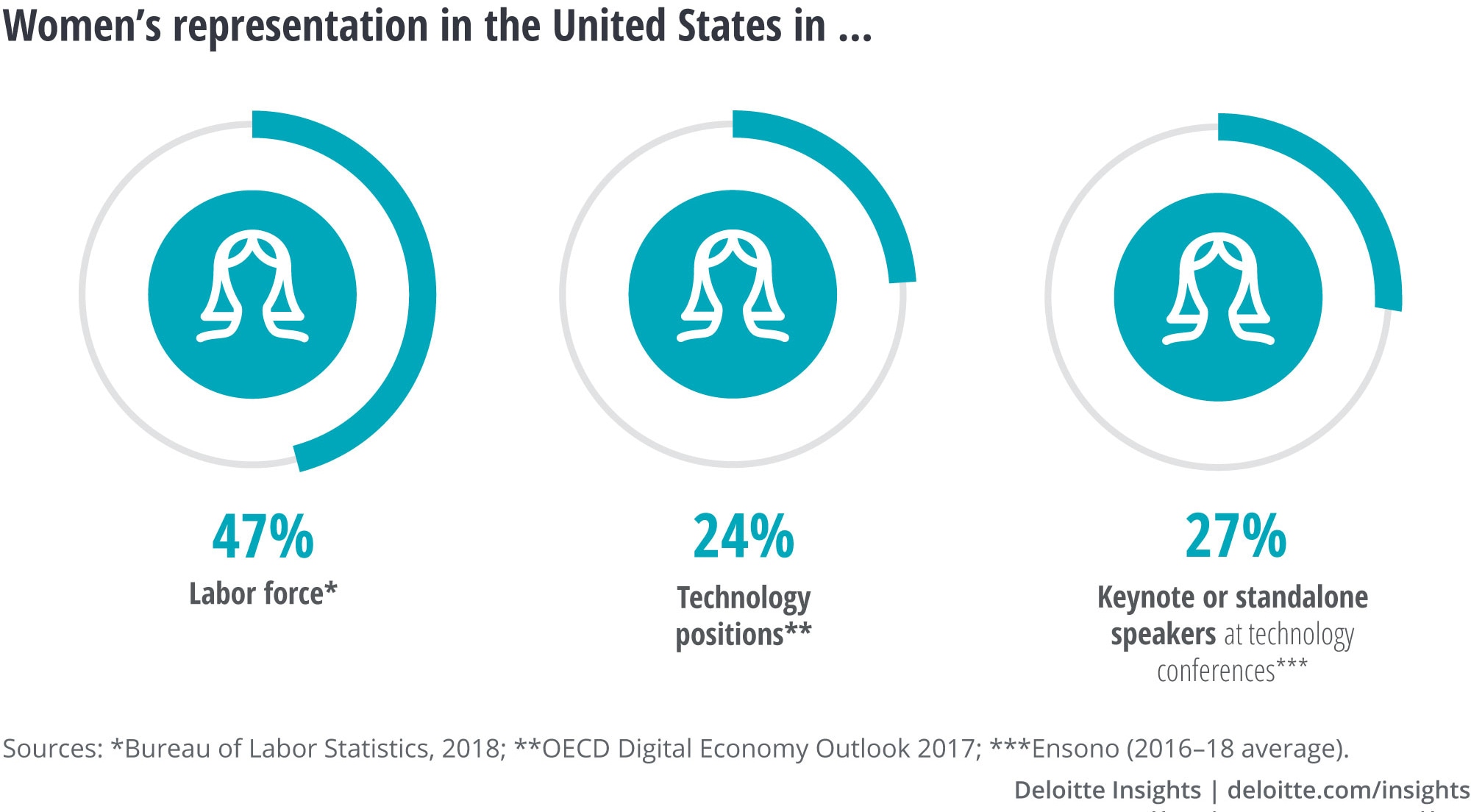Closing the tech conference gender gap Increasing women’s representation on the technology stage
4 minute read
18 March 2020
The dearth of female speakers at tech conferences is a symptom of the industry's gender gap. Awareness and a bit of extra effort may go a long way toward alleviating the shortfall.

In 2017, a tech company product manager began tweeting about nearly empty women’s restrooms at big tech conferences.1 When these humorous observations went viral, her company was inspired to study women’s representation and experiences at these events. The company’s audit of speaker lineups from major 2016–18 US technology conferences revealed that, on average, only 27 percent of keynote or standalone speakers were female—on par with women’s representation in American tech jobs but far from their portion of the national labor force (see figure).2
Learn more
Explore the Thinking Fast series library
Subscribe and never miss a charticle
Listen to the podcast on Fostering diversity, equity and inclusion in tech, media, and telecom
Learn more about Deloitte’s services
Go straight to smart. Get the Deloitte Insights app.
Male-dominated stage lineups are a global phenomenon: Event software company Bizzabo used facial analytics software to scan 60,000 speaker images from thousands of professional events in 23 countries over five years, deducing that 78 percent of tech event speakers are male.3 And a survey of 500 women in the United States and United Kingdom who have attended tech conferences revealed that 70 percent of panelists reported being the “lone woman.”4
In recent years, critics have reproached tech conference organizers for failing to book any female keynote speakers or for having all-male panels (even when discussing, of all things, gender equality).5 However, a shift is occurring, and many prominent tech conferences are diversifying their speaker lineups. The Consumer Electronics Show won praise this year for featuring four female speakers (out of nine) on its keynote stage.6
How much female representation is enough? Some have pointed out that when a tech conference speaker lineup is one-quarter female, it mirrors the representation of women in tech positions. But that highlights a more fundamental issue: Should the industry be satisfied with women’s share of tech positions—and speaking roles—at just 25 percent?
With research showing that diverse teams perform better and are more innovative, leaders across industries are recognizing that a diverse workforce is, as advocates have long suggested, good for business.7 As the tech industry seeks to shape the future, it is aiming to be more representative of that future. Google CEO Sundar Pichai has explained, “A diverse mix of voices leads to better discussions, decisions, and outcomes for everyone.”8
That sentiment applies equally well to tech conferences, which represent a conversation among leaders and practitioners about what’s important for the industry, now and in the future. Bringing speakers with a wider range of perspectives and ideas onto the stage—and more diverse participants into the audience—can be good for creatively driving the conversation and advancing the industry. Moreover, ensuring more female researchers and leaders on stage can give them greater visibility as role models—which may help move the needle on women’s overall tech industry representation.
There are steps that conference organizers, participating companies, and potential speakers can take to help make tech events more diverse:9
- Consider drafting and posting diversity guidelines or policies for events your organization participates in or runs.10
- Encourage speakers from diverse backgrounds to apply for speaking opportunities. Consider ways your company can support and mentor new speakers on writing proposals, crafting presentations, and presenting.
- Commit to creating more diverse speaker lineups. Rather than inviting the same luminaries year after year, look for upcoming stars—perhaps at a level below where you ordinarily look. Consider highlighting diversity guidelines in your calls for proposals/speakers, asking speakers for recommendations of additional experts from underrepresented groups, using professional networking sites to seek out novel speakers, consulting databases of experts/speakers,11 and reviewing guides for making events more inclusive.12
- If you’re a frequent speaker, consider establishing a policy on whether you’ll take part only in diverse panels and events. The director of the National Institutes of Health has set one notable example with his plea for an end to all-male panels.13
© 2021. See Terms of Use for more information.
More from the Technology collection
-
M&A premiums surge as pool of targets subsides Article5 years ago
-
Talent and workforce effects in the age of AI Article5 years ago
-
Ecosystem-driven portfolio strategy Article5 years ago
-
Tech Trends 2025 Article3 months ago
-
TMT Predictions 2025 Article4 months ago











